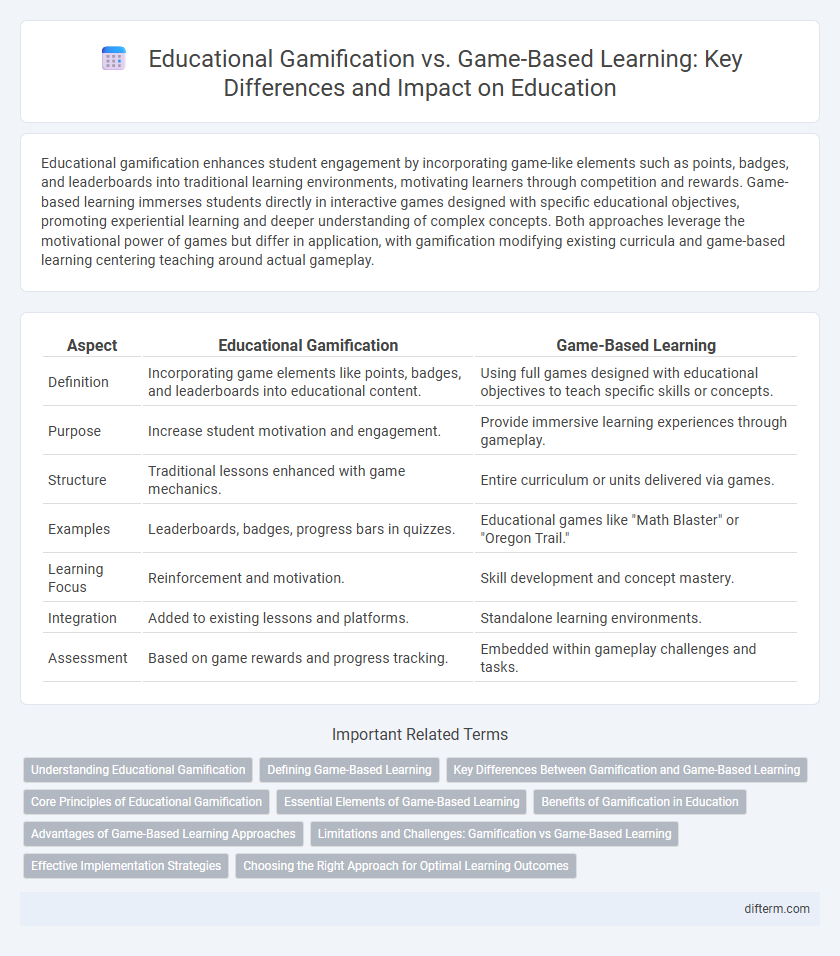Educational gamification enhances student engagement by incorporating game-like elements such as points, badges, and leaderboards into traditional learning environments, motivating learners through competition and rewards. Game-based learning immerses students directly in interactive games designed with specific educational objectives, promoting experiential learning and deeper understanding of complex concepts. Both approaches leverage the motivational power of games but differ in application, with gamification modifying existing curricula and game-based learning centering teaching around actual gameplay.
Table of Comparison
| Aspect | Educational Gamification | Game-Based Learning |
|---|---|---|
| Definition | Incorporating game elements like points, badges, and leaderboards into educational content. | Using full games designed with educational objectives to teach specific skills or concepts. |
| Purpose | Increase student motivation and engagement. | Provide immersive learning experiences through gameplay. |
| Structure | Traditional lessons enhanced with game mechanics. | Entire curriculum or units delivered via games. |
| Examples | Leaderboards, badges, progress bars in quizzes. | Educational games like "Math Blaster" or "Oregon Trail." |
| Learning Focus | Reinforcement and motivation. | Skill development and concept mastery. |
| Integration | Added to existing lessons and platforms. | Standalone learning environments. |
| Assessment | Based on game rewards and progress tracking. | Embedded within gameplay challenges and tasks. |
Understanding Educational Gamification
Educational gamification involves integrating game mechanics such as points, badges, and leaderboards into non-game learning environments to enhance student engagement and motivation. This technique leverages reward systems and competition to promote active participation and reinforce learning objectives without requiring complete game narratives. Understanding educational gamification helps educators design interactive experiences that improve knowledge retention and foster a productive learning atmosphere.
Defining Game-Based Learning
Game-Based Learning (GBL) involves the use of actual games designed with specific educational objectives, allowing students to engage in interactive, immersive experiences that promote skill development and knowledge retention. Unlike educational gamification, which applies game-like elements such as points and badges to traditional learning environments, GBL centers around playing full-fledged games that align with curricular goals. Research shows GBL enhances motivation and problem-solving abilities by providing contextual learning scenarios where students apply concepts actively.
Key Differences Between Gamification and Game-Based Learning
Gamification integrates game mechanics such as points, badges, and leaderboards into non-game educational activities to increase engagement and motivation. Game-based learning involves using actual games designed with educational objectives to facilitate deeper understanding and skill development. While gamification enhances traditional lessons through motivational elements, game-based learning immerses students in interactive environments that promote active problem-solving and critical thinking.
Core Principles of Educational Gamification
Educational gamification centers on integrating game mechanics such as points, badges, and leaderboards into non-game learning environments to boost motivation and engagement. Core principles include clear learning objectives, immediate feedback, challenge balancing, and fostering intrinsic motivation through meaningful rewards. Unlike game-based learning, which uses entire games to teach content, gamification enhances traditional education by embedding actionable game elements that support knowledge retention and active participation.
Essential Elements of Game-Based Learning
Game-based learning incorporates essential elements such as clear objectives, immediate feedback, and adaptive challenges to enhance student engagement and knowledge retention. Unlike basic educational gamification that adds game-like features superficially, game-based learning integrates immersive narratives and problem-solving tasks that foster critical thinking. Core components include motivation through rewards, collaboration opportunities, and iterative learning experiences tailored to individual skill levels.
Benefits of Gamification in Education
Gamification in education leverages game elements such as points, badges, and leaderboards to enhance student engagement and motivation, leading to improved learning outcomes. By incorporating challenge, competition, and rewards, gamification fosters active participation and encourages consistent effort among learners. This approach supports personalized learning paths and real-time feedback, resulting in increased retention and deeper understanding of educational content.
Advantages of Game-Based Learning Approaches
Game-based learning harnesses interactive gameplay to enhance student engagement and motivation, leading to improved knowledge retention and critical thinking skills. It fosters experiential learning by allowing learners to apply concepts in immersive scenarios, promoting deeper understanding compared to traditional methods. This approach also supports personalized learning paths, adapting challenges to individual skill levels for optimal cognitive development.
Limitations and Challenges: Gamification vs Game-Based Learning
Educational gamification often faces challenges such as reduced student motivation due to overemphasis on extrinsic rewards and potential lack of deep cognitive engagement. Game-based learning encounters limitations including high development costs, technical complexity, and difficulties aligning games with specific curriculum standards. Both approaches require careful integration to balance engagement with meaningful educational outcomes and to address accessibility issues across diverse learner populations.
Effective Implementation Strategies
Effective implementation of educational gamification involves integrating game elements such as points, badges, and leaderboards into existing curricula to enhance student motivation and engagement. Game-based learning requires the purposeful design of educational games that align with learning objectives, fostering critical thinking and problem-solving skills through immersive experiences. Leveraging data analytics to monitor progress and adapt game mechanics ensures personalized learning paths and maximizes instructional effectiveness.
Choosing the Right Approach for Optimal Learning Outcomes
Educational gamification leverages game elements such as points, badges, and leaderboards to motivate learners without altering the core curriculum, enhancing engagement and retention. Game-based learning involves using fully designed games where gameplay directly teaches concepts, promoting critical thinking and problem-solving skills through immersive experiences. Selecting between gamification and game-based learning depends on specific educational goals, learner preferences, and subject matter complexity to ensure optimal learning outcomes.
educational gamification vs game-based learning Infographic

 difterm.com
difterm.com